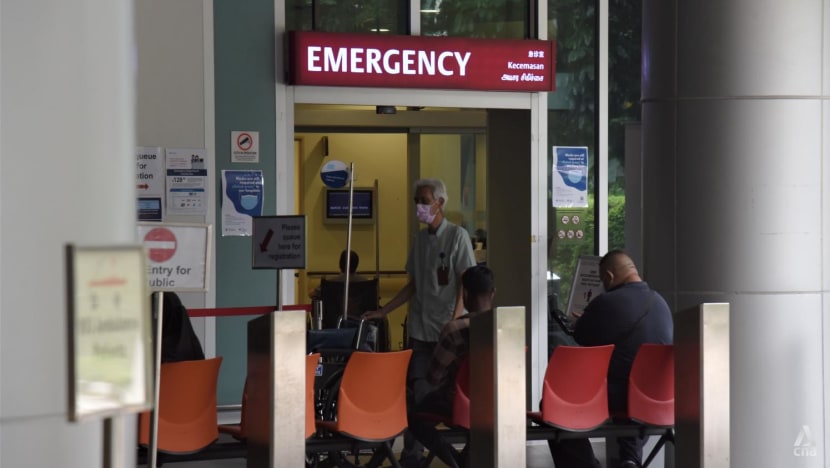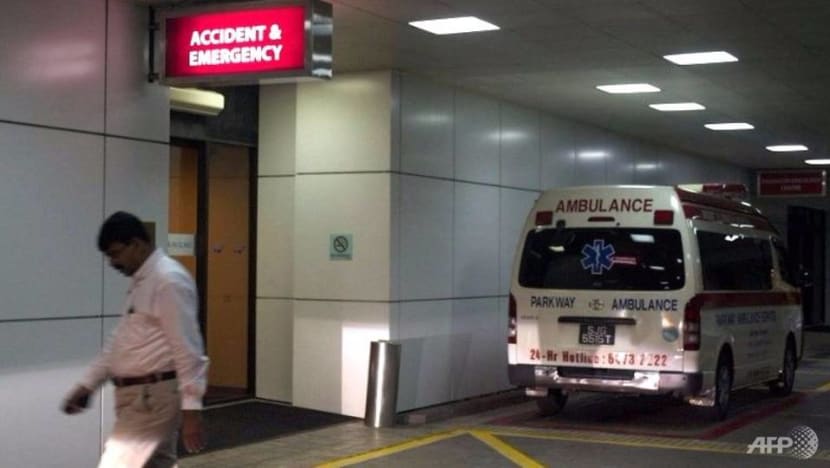'They just want MC': People still visiting hospitals for minor conditions as COVID-19 cases spike in Singapore
Hospitals, nurses and doctors at emergency departments tell CNA what should, and is, being done to prevent overcrowding amid the coronavirus surge.

File photo of Emergency Building at Ng Teng Fong General Hospital in Singapore. (Photo: CNA/Javier Lim)
This audio is AI-generated.
SINGAPORE: When May, a public hospital nurse, recently asked some younger COVID-19 patients why they chose the emergency department (ED) for treatment, they said they preferred it over seeing a general practitioner (GP).
This was despite the Health Ministry’s (MOH) recommendation to seek medical help at emergency departments only for serious or life-threatening emergencies, amid a significant uptick in coronavirus cases this month.
May, who only wanted to be known by her first name and has been an emergency department nurse for almost five years, added: “Some elderly patients really need to come to ED because of their condition.
"I don’t blame them for coming but young (patients) come to ED and they just want MC (medical certificate) and some paracetamol.”
May, as well as another nurse and an emergency medicine physician, spoke to CNA about how such instances have led to high volumes of patients in their respective hospitals’ emergency departments during the current festive season, which in turn impact healthcare staff like them.
While emergency departments have experienced higher patient volumes in recent years, especially when new COVID-19 variants circulated in the community, Singapore has not seen such a spike in cases for several months.
The estimated number of COVID-19 cases from Dec 3 to 9 increased to 56,043, a 75 per cent jump compared with 32,035 cases in the previous week.
This further increased to 58,300 for the week of Dec 10 to 16, according to the Ministry of Health’s latest figures published on Thursday (Dec 21).
The number of new COVID-19 patients admitted to hospitals jumped to 965 in the past week, up from 763 the previous week and 460 the week before. Similarly, 32 patients were admitted to intensive care units in the past week, up from 23 the previous week and nine the week before.
The average daily hospitalised cases recorded are also the highest for the year. The 560 cases are up from 350 cases the previous week and 225 the week before that.
The vast majority of cases now come from the JN.1 strain – classified by the World Health Organization as a “variant of interest” – though it is not more severe than other past variants.
Infectious diseases experts have also said the surge is due to various factors, including time between vaccinations, fewer people wearing masks, and an increase in travel during the school holidays that began last month.
LONGER WAITING TIME AT HOSPITALS
As waiting times for hospital beds are also on the rise, some hospitals told CNA about their measures to avoid overcrowding at their emergency departments and how they are helping to improve staff well-being.
A spokesperson from Tan Tock Seng Hospital said bed wait times and occupancy rates “have been trending on the higher side in recent weeks”, due to the surge in COVID-19 cases and more patients – especially elderly ones – requiring longer stays in the wards.
Similarly, Sengkang General Hospital said that wait times and admissions “may take longer” due to a higher patient load.
Latest figures from MOH show the median waiting time to be warded has risen at some hospitals in recent weeks.
Data showed that for the week from Dec 10 to Dec 16, median waiting times exceeded 20 hours at Changi General Hospital and Khoo Teck Puat Hospital on Dec 11 and Dec 12.
The median waiting time at Tan Tock Seng Hospital hit 19 hours on Dec 12 – the highest the hospital has seen this year. It also reached 17.8 hours on Dec 13, the hospital's second-highest median waiting time of the year.
There was also an increase in median waiting times at Ng Teng Fong General Hospital, hitting 17.3 hours on Dec 15.
A spokesperson from Raffles Hospital, a private facility, said it saw more cases at its acute and critical care department as well as its clinics across Singapore in late November and early December.
MANPOWER CONSTRAINTS
Ms Dhaatchaayani, also an emergency department nurse at a public hospital, said that staff like herself are now more aware of how to protect themselves and contain COVID-19 through precautionary measures.
Nevertheless, she concurred with May that most emergency department patients currently do not require emergency care. These unnecessary visits “risk compromising the standard of care” for other patients who genuinely need emergency assistance, she said.
She added: “On top of treating patients, staff like us who work as frontliners are at risk for exposure.
“The risk for exposure leads us to fall ill, which constraints the overall manpower.”
May said that patients are still coming to the emergency department for minor injuries like back or toe pain, while some younger ones seek emergency treatment for symptoms like a high fever, runny nose or cough. They do not go to a GP clinic, citing reasons like clinics being closed or long queues there.
“I asked these patients, ‘Why you never go see GP doctors earlier?’, because their fever and cough are like three to four days. They said they don’t want and they prefer ED,” May added.
“They should stay at home and can recover by themselves. Nowadays there are (telemedicine) platforms, so they can get MC from there and do consultations.”

James (not his real name), an emergency physician of six years and who works at a public hospital, noted that it is a “constant pattern” for some patients to visit the emergency department for minor conditions such as a cut or high fever due to a lack of options, especially after hours.
The doctor's name has been changed as he is not authorised to speak to the media. All three healthcare workers declined to reveal to CNA the hospital they work at.
James said that while overnight or 24-hour clinics are an option, they might be too far away and cost just as much as going to the hospital.
Despite patients coming in for non-emergency conditions, James said that he understands why they do so.
“Let’s say you have a child and she has a fever of 40 degrees Celsius at 1am. It’s a minor condition which you can wait till the next day to go to the hospital or you can self-medicate,” he added.
“But would you (wait) or would you want to go see a doctor to just get some reassurance?”
He added that people generally take it well when told that they do not need to visit the hospital for their condition. However, there are some patients who “take it very badly”.
“It’s like, ‘This condition, it looks very mild to you but this feels very serious to me. So who are you to say that I shouldn’t be coming to A&E (accident and emergency department)?’” James said.
Asked if the workload ever gets too much to handle, James said that healthcare staff like himself have come to accept that this is part of the service they provide.
However, he added that when staff fall sick due to COVID-19, it makes the operation staffing “very hard to run” when they are seeing more patients with illnesses on a reduced capacity.
WHO SHOULD VISIT THE EMERGENCY DEPARTMENT?
Hospitals CNA spoke to urged those with mild to moderate symptoms to visit a GP clinic or polyclinic near their home.
“For those who are unwell with symptoms of COVID-19 or other respiratory infections, we encourage them to visit their family doctor first to determine the severity of their condition instead of heading to the ED,” said Sengkang General Hospital.
“This will avoid crowding at EDs so that we do not delay the delivery of urgent care to those who need it.”
The hospitals added that only those who experience severe COVID-19 symptoms such as shortness of breath or individuals with serious or life-threatening emergencies should visit the emergency department.
A spokesperson from Raffles Hospital highlighted that everyone could also do their part by practising good hygiene and taking necessary precautions.
This includes wearing a mask when in crowded places, and doing an antigen rapid test (ART) test if they experience any COVID-19 symptoms such as fever or chills, sore throat, loss of sense of taste or smell, or headache.
COPING WITH SURGE IN CASES
To manage the increased number of patients in their emergency departments, some hospitals offer suitable patients the option to receive “hospital-level care” while remaining at their homes.
Sengkang General Hospital told CNA that patients assessed to have stable medical conditions could have their treatment started promptly at the emergency department and subsequently continued at home.
A spokesperson for the National University Health System (NUHS) also noted that alternative arrangements such as teleconsultation, tele-rehabilitation and monitoring, and delivery of medicines can be provided where clinically appropriate.
NUHS manages the National University Hospital, Ng Teng Fong General Hospital, Jurong Community Hospital and Alexandra Hospital.
Over at Singapore General Hospital, suitable patients may also be transferred from the emergency department and inpatient wards to Outram Community Hospital or Transitional Care Facilities for step-down care.
In addition, more elective inpatient surgeries are being done as day surgeries, said Associate Professor Lee Haur Yueh, acting chairman of Singapore General Hospital's medicine division.
“Some patients are cared for in a short-stay ward where they are monitored for less than 24 hours after the surgery. This initiative helps to free up hospital beds for acute admissions from ED,” Assoc Prof Lee added.
“Rescheduling of elective care is only done after careful deliberation by the clinical team to ensure that the clinical condition of the patients safely allows for that."
Patients at Sengkang General Hospital are discharged earlier at 11.30am instead of 1pm, which increases the number of beds available and reduces the long bed waiting time at the emergency department.
“For patients who might experience a longer wait time to be transferred to the ward, the specialty doctor from the inpatient team would have already started care management within the ED,” the hospital said.
Meanwhile, NUHS said that it is deploying surge capacity in its hospitals’ inpatient facilities such as the intensive care and isolation units.
The spokesperson for the healthcare cluster added that it is also working closely with MOH on contingency planning, including ensuring sufficient manpower and deferring non-urgent elective operations to maximise bed capacity for urgent cases in need of acute care.
“Where necessary, we are redeploying and increasing our manpower to better support high attendance at our EDs,” said the spokesperson.
“Our triage process includes having a senior emergency physician review the cases for admission to the hospital to ensure appropriate right-siting and avoid unnecessary admission.”
Some hospitals also highlighted that they already have measures in place to deal with the surge. For Tan Tock Seng Hospital, these include optimising extended facilities at their emergency department and wards, as well as arrangements with community partners to ensure continued care for the patients.
The hospital’s spokesperson said: “(Patients) needing immediate life-threatening intervention are treated first, while those with minor ailments would have to wait.”
For patients who are waiting for ward beds to be available, the hospital’s care teams will review and begin treatment at the emergency department itself so that specialist care starts early.
Likewise, Raffles Hospital said that it has established protocols for dealing with COVID-19.
“(We) are experienced in dealing with a situation where numbers (have) increased,” said the spokesperson.
“In line with protocols, we have been triaging patients during registration. We will prioritise and attend to patients who require urgent care.”
Apart from measures to manage patients, some of the hospitals CNA spoke to are also taking care of their staff.
The NUHS spokesperson said that initiatives have been rolled out since the start of COVID-19 to support the mental welfare of hospital staff. This includes resilience workgroups to strengthen their mental health and a well-being office that offers walk-in counselling services.
Tan Tock Seng Hospital also pointed out that its staff are “busier than usual” across its emergency department and all wards, and that support and well-being measures are in place to help them cope during this period.
“We are working hard to augment more staff to better support the current surge.”










